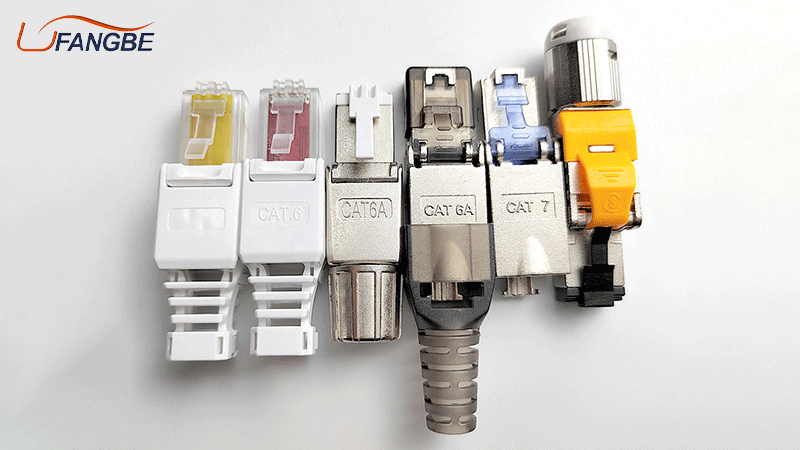Stay tuned
To learn more about the latest news of FANGBEI.
2024-05-25

The termination of a shielded Cat6a field plug is an essential step in creating a reliable and high-performance network connection. A Cat6a field plug is a modular connector that can be terminated in the field, without the need for specialized equipment or a dedicated workstation. The shielded design of the plug provides additional protection against electromagnetic interference (EMI) and ensures that the signal integrity of the network is maintained, even in challenging environments. Proper termination of the shielded Cat6a field plug is critical to ensure a stable and secure network connection that meets the demands of today’s high-bandwidth applications.
The Field plugs and Rj45 Connectors are both types of connectors used in networking and telecommunications applications, but they have some differences in terms of their features and applications.
Field plugs are modular connectors that can be terminated in the field without the need for specialized equipment or a dedicated workstation. They are designed to be quick and easy to install and can be used in a variety of environments, including harsh industrial settings. Field plugs typically have a shielded design to provide additional protection against electromagnetic interference (EMI) and to ensure signal integrity.
On the other hand, RJ45 connectors are a type of modular connector that are commonly used in Ethernet networking applications. They are typically pre-terminated and designed to be used with a specific cable type, such as Cat5e or Cat6. RJ45 connectors have a standard design that allows them to be used with a variety of devices, such as switches, routers, and computers. They are not typically shielded and may not provide as much protection against EMI as field plugs.
In terms of installation, field plugs are generally easier and faster to install than RJ45 connectors since they can be terminated in the field without specialized equipment. RJ45 connectors require a crimping tool to terminate the connector onto the cable, which can be more time-consuming and may require more skill.
Overall, both field plugs and RJ45 connectors have their advantages and disadvantages depending on the specific application. Field plugs may be more suitable for harsh industrial environments where protection against EMI is critical, while RJ45 connectors may be more commonly used in standard Ethernet networking applications.
The following are some tools that may be required for terminating a field plug:
Cable cutter: A cable cutter is used to cut the Ethernet Cable to the appropriate length before termination.
Wire Stripper: A wire stripper is used to remove the outer insulation from the Ethernet cable, exposing the inner wires.
Cable jacket stripper: A cable jacket stripper is used to remove the outer jacket from the Ethernet cable to expose the individual pairs.
Cable preparation tool: A cable preparation tool is used to properly prepare the individual wires and pairs before termination.
Crimp tool: A crimp tool is used to attach the field plug to the Ethernet cable by crimping the metal contacts onto the wires.
Continuity tester: A continuity tester is used to check the integrity of the Ethernet cable and to ensure that the individual wires are properly connected to the metal contacts.
Cable tie: A cable tie is used to secure the Ethernet cable to a cable tray or other mounting surface.
It is important to note that the specific tools required for field plug termination may vary depending on the manufacturer and model of the field plug. Some field plugs may include a built-in tool for cable preparation or a different type of connector that does not require a crimp tool.
Here is a general process for terminating shielded field termination plugs:
Cut the Ethernet cable to the appropriate length using a cable cutter.
Use a wire stripper to remove the outer insulation from the Ethernet cable, exposing the inner wires.
Use a cable jacket stripper to remove the outer jacket from the Ethernet cable to expose the individual pairs.
Separate the individual pairs and arrange them in the correct order according to the wiring diagram provided by the field termination plug manufacturer.
Use a cable preparation tool to properly prepare the individual wires and pairs before termination. This may involve trimming any excess wire or untwisting the pairs to the correct length.
Insert the prepared wires into the appropriate contacts in the field termination plug, making sure to maintain the correct order.
Use a crimp tool to attach the field termination plug to the Ethernet cable by crimping the metal contacts onto the wires.
If necessary, use a continuity tester to check the integrity of the Ethernet cable and to ensure that the individual wires are properly connected to the metal contacts.
Once the termination is complete, use a cable tie to secure the Ethernet cable to a cable tray or other mounting surface.
It is important to follow the manufacturer’s instructions for the specific type of field termination plug being used, as the termination process may vary depending on the manufacturer and model. Additionally, it is important to properly ground the shielded field termination plug to prevent electromagnetic interference (EMI) and to ensure proper signal integrity.
Fangbei, a premier manufacturer specializing in network connectors, terminals, electronic components, and cutting-edge network tools.

+86 769 8127 1686 +86 186 8105 2977
186 8105 2977